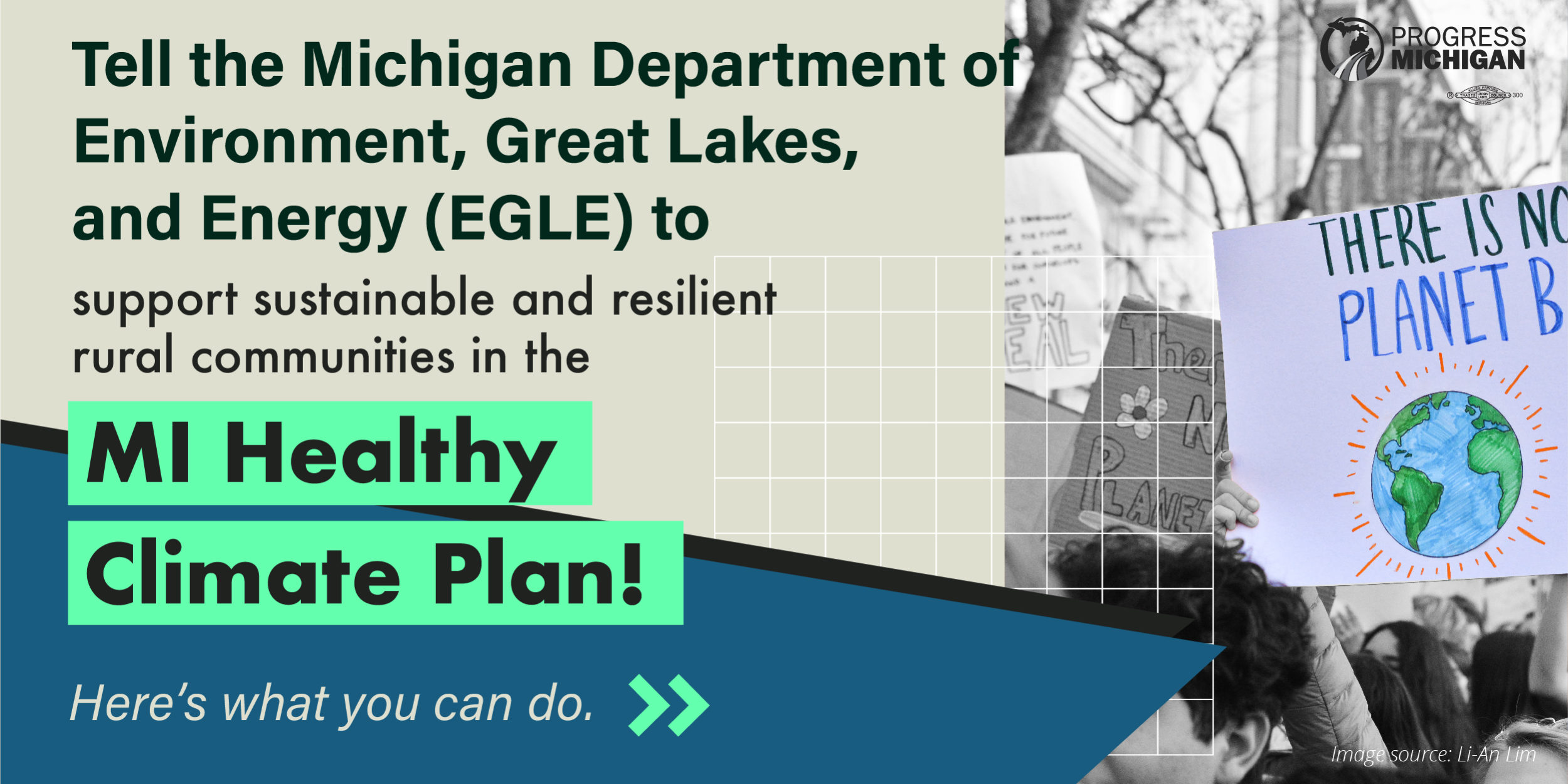Fighting the climate crisis is a team effort. Everyone must get involved if we want to see results that matter. For their part, Gov. Gretchen Whitmer’s administration released its draft MI Healthy Climate Plan, and they’re looking for feedback from the public – that means it’s a perfect opportunity for us to make sure it’s the best it can be!
The MI Healthy Climate Plan is an initiative led by the Michigan Department of Environment, Great Lakes, and Energy (EGLE) that will position Michigan as a leader in fighting the climate crisis. Much like the rest of the world, we’re seeing the effects of rising temperatures here in our Great Lakes. It’s affecting our agriculture, our ecosystems, and the air we breathe. It’s clear that government resources must be thrust into action to pump the brakes on climate change before it’s too late. And importantly, the plan has got to put the voices of all Michiganders at the center of the conversation, especially for rural and small-town residents, from Copper Harbor all the way down to Charlotte.
Since taking office, Gov. Whitmer has committed to combatting the climate crisis, and the release of the MI Healthy Climate plan shows that her administration is serious about taking action. The plan sets forth a goal of zero net carbon emissions by 2050 in the nearly 40-page document. It’s a great step in the right direction if our state wants to lead the charge in addressing the greatest challenge of our lifetime.
The plan isn’t perfect, however, and we think there are ways the team behind the MI Healthy Climate Plan can strengthen it. Some environmentalists point out that must move towards a more aggressive goal of carbon neutrality sooner than 2050 (which is the date MI Healthy Climate sets) and also mention that prioritizing public transportation and natural gas efficiency can help us achieve this goal more quickly. We also believe, along with these concerns, that the MI Healthy Climate Plan must chart out a path for rural Michigan.
The MI Healthy Climate Plan will be strengthened if we include the needs and concerns of rural Michiganders in the plan. So, we’re asking for the MI Healthy Climate Plan to include the following: insights and takeaways from the Upper Peninsula Energy Task Force, attention to regenerative farming practices and agricultural pollution, and alternatives to investor-owned energy utilities. Below you can find out a little more in depth what these changes would mean for the MI Healthy Climate Plan and our environment.
Insights and Takeaways from the Upper Peninsula Energy Task Force
First, we encourage the MI Healthy Climate Plan to build on findings from the Upper Peninsula Energy Task Force (UPETF). The UPETF was created under Gov. Whitmer to find solutions right here in Michigan for alternative, sustainable energy sources. Important findings came from the UPETF to help save families money on heating their homes through frigid Michigan winters by installing electric heat pumps, modernizing and weatherizing existing housing stock, and also pointing to holistic remedies to lower energy consumption like expanding public transportation, which is lacking in rural Michigan.
Attention to Regenerative Farming Practices and Agricultural Pollution
Next, the MI Healthy Climate Plan needs to take a closer look at our state’s food systems and figure out ways this sector can take meaningful steps to reduce its carbon emissions. Many rural communities across the state depend on farming and are already making headway in promoting sustainable agriculture in innovative ways. The MI Healthy Climate Plan should include steps to establish regenerative farming at a larger scale than what is currently proposed. If you’re not too familiar, regenerative farming has been practiced for millennia in Indigenous communities and is just now making an impact in the Western food system. Regenerative farming uses conservation practices, like cover crops and no-till farming, that are more ecologically sound and reduce soil erosion and chemical runoff. Implementing these practices at a large scale, in addition to restricting corrosive factory farming, is essential to mitigate the damage we’re already seeing in our Great Lakes. The plan should also include in a way to reduce agricultural waste that doesn’t rely on repurposing it for energy through processes like anaerobic digestion.
Alternatives to Investor-Owned Energy Utilities
Finally, we need to ensure that impacted communities will have the power to make decisions about their own energy consumption. For decades, electrical cooperatives have led the charge in rural Michigan for delivering quality service at a reasonable cost all while using renewable sources. Along with cooperatives, community choice aggregation (CCA) is increasingly popular throughout the state to address the needs of low-income families and communities of color who have too often been neglected by investor-owned utility corporations. CCA allows residents of a community to have power over decisions over where they get their energy supply, and this is already a reality here in Michigan. The village of L’Anse on the shores of Lake Superior in the Upper Peninsula is doing so as a notable example, and their success can be used as a model for other small towns and rural communities across the state for making a positive impact on residents.
Rural areas deserve attention when it comes to fighting the climate crisis and cannot be ignored when it comes to what our state’s goals should be. The MI Healthy Climate Plan should take meaningful steps to address the issues that matter to rural Michiganders, and we hope they are incorporated into the final draft plan.
You can voice your opinion on the MI Healthy Climate Plan, by submitting a comment here. Discover other ways to engage in the process on EGLE’s website.

